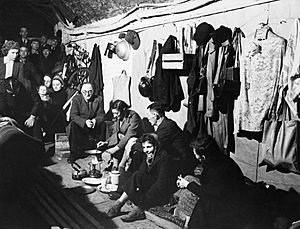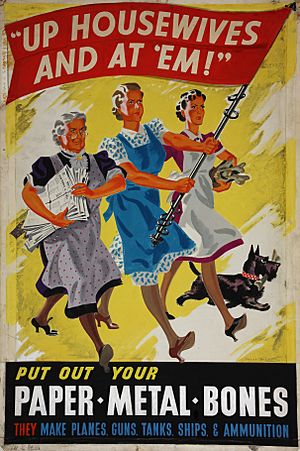United Kingdom home front during World War II facts for kids
| 3 September 1939 – 8 May 1945 | |
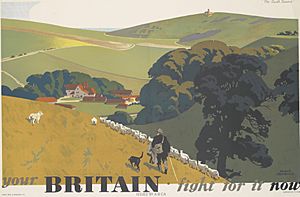
One of a series of posters by Frank Newbould, intended to arouse patriotic feelings for an idealised pastoral Britain.
|
|
| Preceded by | Interwar era |
|---|---|
| Followed by | Postwar era |
| Monarch | George VI |
| Leader(s) | |
During World War II, the United Kingdom home front was all about what happened in Britain itself between 1939 and 1945. This includes the country's politics, how society changed, and its economy during the war.
The war was very expensive. Britain paid for it with high taxes and by selling off some of its valuable things. It also received a lot of help from the US and Canada through something called Lend Lease. The US gave about $30 billion in supplies that didn't need to be paid back. Canada also gave aid.
Britain did a great job of getting everyone involved in the war effort. This helped them win by keeping strong public support. People called it a "people's war." This idea led to a demand for better social support after the war. By 1945, a plan for a welfare state was ready. This meant the government would provide more services for everyone. The Royal family also played a big part. They stayed in London during the Blitz bombings. They also visited soldiers, factories, and hospitals across the country.
British people volunteered a lot to help. Factories made many more weapons and kept them high quality. Growing food became very important to save ships for carrying war supplies. Farmers grew crops on much more land. The number of farm workers also grew, thanks to the Women's Land Army.
Contents
Politics and Planning for the Future
Planning for a Better Society
The tough times during the war made people agree on something new. They wanted a better welfare state after the war. This included social security for everyone and a free national health service. They also wanted better schools, more homes, and money for families. The government had already started new services during the war, like hospitals and school lunches. This made people support a bigger welfare state. All the main political parties agreed on this.
Life got a bit fairer during the war. Rich people and office workers saw their incomes drop due to high taxes. But blue-collar workers benefited from rationing and price controls. People wanted an expanded welfare state as a reward for their sacrifices. The Labour Party pushed for this. But the Conservatives led the Education Act of 1944. This law greatly improved secondary schools in England and Wales. Historians see it as a big step forward.
William Beveridge from the Liberal Party wanted to fight five "giant evils." These were Want, Disease, Ignorance, Squalor, and Idleness. He suggested making social services better and available to everyone. Unemployment and sickness benefits would be for all. New benefits for mothers would also be added. The old-age pension system would be updated. A full National Health Service would give free medical care to everyone. All major parties agreed with these ideas. They were mostly put into action after the war.
Plans for new homes started in 1941. Conservatives thought that more people owning homes would help society. After 1945, expanding home ownership became a key Conservative idea. Labour still preferred public ownership. All parties wanted to build more homes. The plan was for local councils to lead at first. But later, private companies would build most new homes. Local councils would focus on clearing slums and helping those most in need. Money problems in the late 1940s delayed these plans until the 1950s.
Britain's Wartime Economy
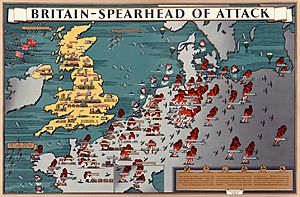
Britain did an amazing job getting everyone involved in the war effort. They got the most workers possible, made the most goods, and put people with the right skills in the right jobs. They also kept people's spirits high. By 1941, Britain's economy was 21% bigger than in 1938. Britain was the most fully prepared nation for war economically. A big reason for this success was how women were organized. They worked in factories, served in the military, and managed homes. This was made official by conscription (required service) after December 1941. Women helped the war effort and made rationing work well.
How Britain Paid for the War
Over six years of war, Britain received about £10 billion. About £1.1 billion came from selling investments. Another £3.5 billion was new borrowing, with £2.7 billion from the British Empire. Canada gave C$3 billion in gifts and easy loans. Most importantly, America provided £5.4 billion in money, loans, and Lend Lease aid. This paid for many weapons, food, oil, machines, and raw materials. Lend Lease supplies delivered during the war were free. But there was a charge for supplies after September 2, 1945. By 1945, Britain's treasury was almost empty.
When the war started, Britain controlled how money left the country. The government used its gold and dollar savings to buy supplies, mostly from the US. By late 1940, British exports were down 37%. Even though Britain had ordered nearly $10 billion worth of goods from America, its gold and dollar savings were running out. The US government then started Lend-Lease in March 1941. Through this, America gave Britain supplies worth $31.4 billion that did not have to be paid back.
Factories and Production
Britain is an island nation. So, when war started in 1939, it relied on imports by sea for many supplies. Air travel for cargo wasn't common yet. But it would have been just as risky. People immediately started recycling to save rare materials. Garden railings were taken for scrap metal. Aluminum kitchen pots were collected for aircraft parts. Even if some benefits were overestimated, everyone helped the war effort.
Britain was very successful at making weapons at home. They also used the Empire and the US to build a large stock of high-quality weapons. Factories changed to make war supplies, and production soared. For example, the government's Materials Committee tried to balance what civilians and the military needed. But military needs came first. Making aircraft was the top priority. The government focused on only five types of aircraft to make them as fast as possible. They got special treatment for materials and workers. Cost was not an issue. New fighter planes increased from 256 in April to 467 in September 1940. This was more than enough to cover losses. Fighter Command won the Battle of Britain in October with more planes than they started with. From 1941, the US provided $15.5 billion in weapons through Lend Lease.
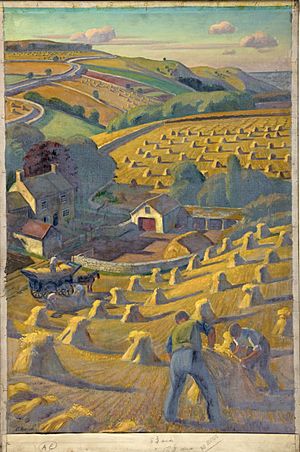
Farms and Food Production
Before the war, Britain imported 70% of its food. During the war, home farming increased by 35%. In terms of calories, food grown in Britain almost doubled. With imports and rationing, British people were well-fed. They ate less meat (down 36% by 1943) but more wheat (up 81%) and potatoes (up 96%).
Farmers grew crops on more land, from 12 million to 18 million acres. The number of farm workers grew by a fifth. This was thanks to the Women's Land Army. Farm women had more duties because young men were away fighting. Prisoners of war from Italy and Germany also helped. The Women's Land Army brought tens of thousands of young women from cities to work on farms. They earned about 30 shillings a week. Wages for male farmworkers who were available tripled to £3 a week.
A new job was harvesting timber. The government set up the Women's Timber Corps for this. It was part of the Women's Land Army and operated from 1942 to 1946.
For people in towns and cities, the government promoted Victory Gardens. These were small plots where people grew vegetables, fruits, and herbs. About 1.4 million such gardens were made. They helped with food shortages and boosted people's spirits. Growing food in these gardens was seen as a way to be self-sufficient and patriotic.
Rationing Food and Goods
Rationing made sure everyone had a basic amount of essential goods. It also reduced waste and saved shipping space for war supplies. The idea was that everyone shared the sacrifice equally.
Before the war, Britain imported 20 million tons of food each year. This included most of its cheese, sugar, fruits, cereals, and fats. It also imported more than half its meat. Britain had about 50 million people. A main German strategy in the Battle of the Atlantic was to attack ships going to Britain. This was to stop British industry and possibly starve the nation.
To handle shortages, the Ministry of Food started rationing. To buy most rationed items, each person had to register at chosen shops. They got a ration book with coupons. These coupons were only good at that specific shop. The shopkeeper received enough food for their registered customers. Shoppers had to bring their ration books so the coupons could be marked.
Impact on Different Parts of Britain
Scotland's War Effort
The war in 1939 temporarily stopped the decline in heavy industry. Shipyards and factories in cities like Glasgow were very busy. To slow down weapon production, the German air force (Luftwaffe) bombed the Clydeside area. The worst was the Clydebank Blitz in March 1941. It left tens of thousands of people without homes. The damage to housing from the war had long-lasting effects for many years.
Wales During Wartime
Wales had suffered from factories closing and high unemployment in the 1920s and 1930s. The war completely changed its economy. Much of Wales was too far for German bombers. It also had many unemployed men ready for work. So, it became a good place for war industries and weapons factories. The old industries of coal and steel saw a huge new demand. The best coal was already mined. It was getting harder and more expensive to get to the remaining coal. But coal was urgently needed. Shipping it from North America would have overloaded the limited supply system.
Belfast's Experience
Belfast was an important industrial city. It made ships, tanks, aircraft, and many other goods for the war. The high unemployment of the 1930s disappeared. Instead, there were not enough workers. Belfast became a target for German bombing. But it was not well defended. For example, there were only 24 anti-aircraft guns in the city. The government in Northern Ireland had prepared too late. They thought Belfast was far enough away to be safe.
When Germany took over France in 1940, they had airfields closer to Britain. Belfast's fire brigade was too small. There were no public air raid shelters. The government was slow to spend money on them. There were also no searchlights, making it hard to shoot down enemy planes. After seeing the Blitz in London, the government started building shelters. In early 1941, the Luftwaffe flew missions to find targets. The working-class areas in the north and east of the city were hit especially hard. Over 1000 people were killed and hundreds were seriously hurt. Many people left the city fearing more attacks. The bombing showed the terrible slum conditions. In May 1941, the Luftwaffe hit the docks and the Harland and Wolff shipyard. It closed for six months. The Belfast Blitz destroyed half of the city's houses. About £20 million worth of damage was done. The Northern Ireland government was heavily criticized for not being ready. The bombing raids continued until June 1941. From January 1942, US soldiers arrived in Northern Ireland. They were preparing for the Invasion of Normandy in June 1944.
When World War II started, the Admiralty decided to build a large new naval base in Northern Ireland. This base would help protect convoys (groups of ships). It would offer repair and refueling services. Derry was chosen because Londonderry Port was the UK's most western port. This gave the fastest access to the Atlantic Ocean. The naval base was called HMS Ferret. It was a land-based facility given a ship's name. After the war, many captured German U-boats were brought to Lisahally.
Civilian Lives Lost
The government reported that 60,595 civilians were killed. Another 86,182 were seriously hurt directly by enemy attacks.
| Year | Dead | Seriously injured |
|---|---|---|
| 1940 | 23,767 | 30,529 |
| 1941 | 20,885 | 21,841 |
| 1942 | 3,236 | 4,150 |
| 1943 | 2,372 | 3,450 |
| 1944 | 8,475 | 21,989 |
| 1945 | 1,860 | 4,223 |
Of these, 51,509 were killed by bombing. Another 8,398 died from V-1 flying bombs or V-2 rockets. And 148 were killed by artillery attacks. These numbers do not include 1,200 Home Guard members killed on duty. They also don't include 32,000 civilian merchant sailors lost at sea. The total civilian deaths were about 0.1 percent of the UK population. This was about 15 percent of all British war deaths.
Society and Culture During the War
Evacuations for Safety
In the 1930s, people were scared of massive bombings in cities. The government planned to move schoolchildren and others to safer towns and rural areas. Operation Pied Piper started on September 1, 1939. It moved over 3.5 million children and teachers. About half of them were from London. The average child traveled about 40 miles, but some went further. There were no bombings in 1939, so many soon went home.
After a German invasion seemed possible and the Blitz began in September 1940, there was a second big wave of evacuations. This happened in June 1940 from targeted cities. Some children were also evacuated to Canada. Many families moved to safer areas on their own. Most host families got along well with the children. But some children from very poor or unhealthy backgrounds found it hard to trust authority. This experience helped middle-class British people understand the need for more welfare programs. It became clear that even middle-class and rich people needed help. They were bombed out of their homes and schools too.
Dealing with Fear
People in London during the war felt a lot of fear. They worried about losing their homes and belongings. They also feared for their churches, shops, and their own lives. Many saw London as a weak spot for Britain. They worried about people who might be cowardly, especially among the working classes, Jewish people, and children.
Education During Wartime
The quality of basic education in big cities went down. This was due to poor leadership, confusion with evacuations, and school closings. Some school buildings were destroyed by air raids. Others were taken over by the military. Students were also upset by the bombings. There were constant shortages of supplies and teachers. The 1944 Education Act greatly improved secondary schools after 1945. But it did little for elementary schools. Smaller towns not targeted by bombs had less disruption.
Religion and Beliefs
All churches strongly supported the war. They used their buildings to help displaced people and comfort those who were scared. Locally, religious faith remained strong. Prayer and Sunday services helped many people deal with the horrors of war. City people thought about sudden death as they hid in air raid shelters. Some sang:
God is our refuge, be not afraid,
He will be with you all through the raid.
They told stories of miracles protecting Britain. They pointed to the Miracle of Dunkirk. They also talked about how churches and cathedrals miraculously survived the Blitz.
Not all churches survived the bombings. Over 15,000 church buildings were damaged. The Methodists had 9,000 churches, and 800 of them were completely destroyed. Many church volunteers now focused on civil defense.
The Church of England saw itself as the moral guide for the country. A few church leaders, like George Bell, Bishop of Chichester, said that bombing German cities was wrong. They were mostly tolerated. Bishop Bell was criticized by other clergy and not promoted. The Archbishop of York said it was "a lesser evil to bomb the war-loving Germans than to sacrifice the lives of our fellow countrymen."
After the world wars, moral standards in Britain changed a lot. People gained more personal freedom. The Church of England and the Catholic Church tried to stop the rise in divorces. Other churches were learning to accept divorced members.
The Church of England was historically linked to the upper classes. But Archbishop of Canterbury William Temple (1881–1944) was a strong supporter of social justice. He published Christianity and Social Order in 1942. This best-selling book tried to combine faith with helping the poor. It helped the Church of England support the new welfare state. Temple also worked to improve relationships with other religious groups.
Gambling During Wartime
During the war, people had less free time and travel was restricted. So, fewer people went to gambling places like horse and dog racetracks. However, the amount of money bet stayed high. Groups against gambling saw the war as a chance to stop many legal gambling activities. But early efforts to cut down on horse racing, dog racing, and football betting were soon reversed. The government saw gambling as a necessary way for people to relax when other fun activities were limited. This led to more football pools and more illegal bookmakers in neighborhoods. For the first time, there was a lot of betting on Irish horse races, which continued during the war. The government even provided extra fuel for racehorses and dogs to travel.
Women's Role in the War Effort
Historians say Britain did a great job getting everyone involved in the war. This included getting the most workers, making the most goods, and keeping people's spirits high. A big part of this success was how women were organized. They worked in factories, served in the military, and managed homes. This was made official by conscription (required service) after December 1941. Women supported the war effort and made rationing work well.
Sometimes, the government reacted too strongly. They evacuated too many children at first. They closed cinemas, then reopened them when they realized people needed cheap entertainment. They even encouraged people to get rid of pets to save shipping space for pet food. But then they realized they needed pets to control rats and mice. Britain mostly relied on people volunteering. The government's success in providing new services, like hospitals and school lunches, helped people support a bigger welfare state. Weapon production went up a lot, and the quality stayed high. Growing food was very important to free up ships for war supplies.
Parents had less time to watch their children. There were worries about young people getting into trouble. Especially as older teenagers got jobs and copied their older siblings in the military. The government responded by requiring all young people over 16 to register. They also increased the number of clubs and organizations for them.
See also
- Timeline of the United Kingdom home front during World War II
- Military history of the United Kingdom during World War II
- London in World War II
- Ministry of Information (United Kingdom)
- History of the United Kingdom during the First World War
- United States home front during World War II
- Diplomatic history of World War II
|






